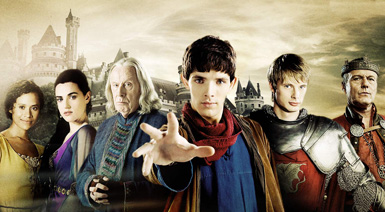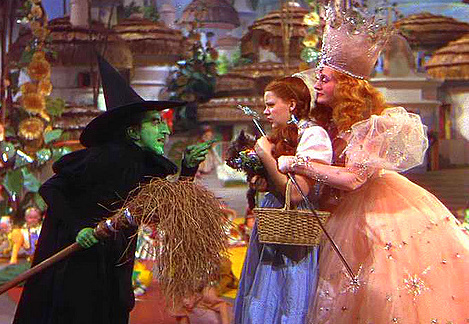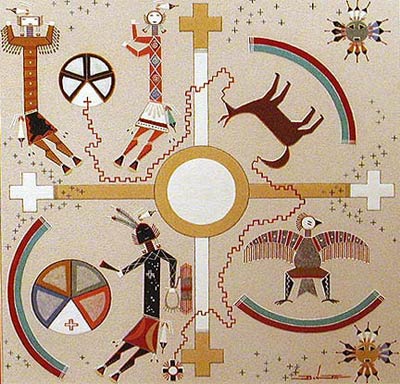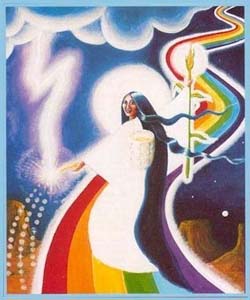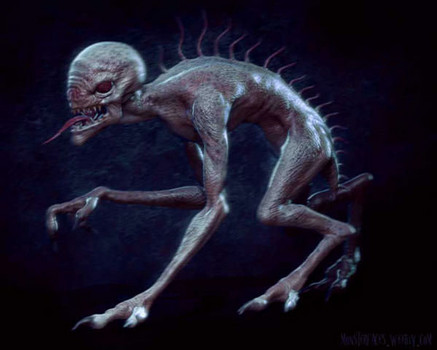The first question we must ask ourselves is what is a trickster when reading or listening to any folklore, mythology, or creationist tale? Within religions, cultures, and stories, the trickster manifests itself in many ways. A trickster can be a god, goddess, spirit, man, woman, or anthropomorphic animal that plays tricks or otherwise disobeys normal rules and conventional behavior. The Coyote mythos is probably one of the most notable characters in most Native American cultures, especially among indigenous peoples of California and Great Basin. Coyote can be categorized in many types. In creation myths, Coyote appears as the Creator himself; but he may at the same time be the messenger, the culture hero, the trickster, the fool, the clown. He has also the ability of the transformer: in some stories he is a handsome young man; in others he is an animal; yet others present him as just a power, a sacred one. Coyotes are not the only tricksters in mythology and folklore. Many other animals represent this role: rabbits, terrapins, butterflies, pumas, crows, monkeys, etc.
In the following group of tales, the tricker is represented by numerous creatures:

Tricksters
The Trickster Tricked
A Native American Legend (Creek/Muscogee Tribe) retold by S. E. Schlosser
Rabbit and Terrapin met near the stream one morning. It was a lovely clear day, and they both basked in the warm sunshine and swapped some stories. Rabbit started boasting that he was the fastest runner in the world. Terrapin wasn’t having any of that! No sir!
“I bet I can beat you in a race,” Terrapin said to Rabbit. Rabbit laughed and laughed at the idea.
“You crawl so slow you hardly look like you are moving,” Rabbit said. “You’ll never beat me!”
Terrapin was mad now. “I will win the race. You meet me tomorrow morning right here,” said he. “I will wear a white feather on my head so you can see me in the tall grass. We will run over four hills, and the first one to reach the stake at the top of the fourth hill will be the winner.”
Rabbit laughed again and said: “That will be me! I will see you tomorrow for the race!” Then Rabbit hopped off, still chuckling to himself.
Terrapin was in a bind now. He knew he could not run faster than Rabbit. But he had an idea. He gathered all of his family and told them that their honor was at stake. When they heard about the race, the other turtles agreed to help him.
Terrapin gave each of his family members a white feather, and placed them at various stages along the route of the race. The first was at the top of the first hill, the second in the valley, the third at the top of the second hill, and so on. Then Terrapin placed himself at the top of the fourth hill next to the winner’s stake.
The next morning, Rabbit came down to the stream and found Terrapin with his white feather waiting at the starting line. “Ready, set, go!” said the Rabbit and he ran up and up the first hill. The Terrapin with the white feather started crawling along behind him. As soon as Rabbit was out of sight, he disappeared into the bushes.
As Rabbit reached the top of the first hill, he saw ahead of him Terrapin with his white feather crawling as fast as it could go down into the valley. Rabbit was amazed. He put on a burst of speed and passed the Terrapin with the white feather. As soon as Rabbit had his back turned, the second Terrapin took off the white feather and crawled into the bushes, chuckling to himself.
When Rabbit reached the valley floor, there was Terrapin ahead of him again, crawling up the second hill with his white feather. Rabbit ran and ran, leaving Terrapin far behind him. But every time he reached a hilltop or a valley, there was Terrapin again with his white feather, crawling along as fast as he could go!
Rabbit was gasping for breathe when he reached the bottom of the third valley. He had passed Terrapin yet again at the top of the third hill, but here was that rascally turtle appearing on the racetrack ahead of him, crawling as fast as he could go up the slope of the fourth hill.
Rabbit was determined to win the race, so he plucked up the last few ounces of his strength and sprinted up the hill, passing the Terrapin with the white feather. He was nearly there! Rabbit rounded the last corner and braked to a halt in astonishment. Sitting by the stake, waving his white feather proudly, was Terrapin. He had won the race!

Coyote
Coyote and Wishpoosh
from the Chinook tribe, retold by S.E. Schlosser
Now Wishpoosh the monster beaver lived in the beautiful Lake Cle-el-lum which was full of fish. Every day, the animal people would come to the lake, wanting to catch some fish, but Wishpoosh the giant beaver drove them away with many threats and great splashing. If they refused to leave, Wishpoosh would kill the animal people by dragging them deep into the lake so that they drowned.
Coyote was very upset at Wishpoosh for the way he treated the animal people. Coyote decided that he would kill the monster beaver and so he went to Lake Cle-el-lum with his spear tied to his wrist and started to fish. As soon as Wishpoosh saw this upstart person invading his territory, the giant beaver attacked. Coyote threw the spear and it pierced the beaver. Immediately, Wishpoosh dove to the bottom of the lake, dragging Coyote with him.
Well, Coyote and Wishpoosh wrestled and tugged and fought each other at the bottom of the lake until the sides gave way and all the water rushed out, pouring out over the mountains and through the canyons until it collected in Kittitas Valley and formed another, larger lake. Coyote and Wishpoosh burst forth into the new lake, shouting and wrestling and fighting each other with renewed vigor until the second lake gave way and the water rushed out, joining in with the waters of several rivers to form a massive lake at Toppenish.
Wishpoosh the monster beaver would not give up the fight. He bit and clawed at Coyote and tried to drown him in the massive lake. Coyote fought back fiercely, and at last the massive lake gave way, the water roared down into the meeting place of the Columbia, the Yakima, and the Snake, where it dammed up into a lake so huge none has ever seen its like before or since.
Coyote and Wishpoosh dragged at each other, pulling and tugging and ripping and biting until the dam gave way and a huge wave of water swept down the Columbia River towards the sea. Coyote and Wishpoosh were tumbled over and over again as they were swept down river in the mighty wave of water. Coyote grabbed bushes and rocks and trees, trying to pull himself out of the massive wave. By these efforts was the Columbia Gorge was formed. But Coyote could not pull himself out of the great wave and so he tumbled after Wishpoosh, all the way to the bitter waters at the mouth of the river.
Wishpoosh was furious. He was determined to beat this upstart Coyote who had driven him from his beautiful lake. The giant beaver swept all the salmon before him and ate them in one gulp to increase his strength. Then he swam out to sea with Coyote in pursuit. The monster beaver threw his great arms around a whale and swallowed it whole.
Coyote was frightened by this demonstration of the monster beaver’s strength. But he was the most cunning of all the animals, and he came up with a plan. Turning himself into a tree branch, Coyote drifted among the fish until Wishpoosh swallowed him. Returning to his natural form, Coyote took a knife and cut the sinews inside the giant beaver. Wishpoosh gave a great cry and then perished.
Coyote was tired after his long fight with the monster beaver. He called to his friend Muskrat, who helped drag the body of Wishpoosh to shore. Coyote and Muskrat cut up the giant beaver and threw the pieces up over the land, thus creating the tribes of men. The Nez Perce were created from the head of the giant beaver, to make them great in council. The Cayuses were created from the massive arms of Wishpoosh, in order that they might be strong and powerful with the war club and the bow. From the beaver’s ribs, Coyote made the Yakimas and from the belly the Chinooks. To make the Klickitats, Coyote used the beaver’s legs, so that they would become famous for their skill in running. With the leftover skin and blood, he made the Snake River Indians who thrived on war and blood.
Thus were the tribes created, and Coyote returned up the mighty Columbia River to rest from his efforts. But in his weariness, Coyote did not notice that the coastal tribes had been created without mouths. The god Ecahni happened along just then and fixed the problem by assembling all of the coastal tribes and cutting mouths for them. Some he made too large and some he made crooked, just as a joke. This is why the mouths of the coastal tribes are not quite perfect.

Amazon Blue Morpho Butterfly
The Wings of the Butterfly (A Brazilian Tale of the Amazon Rainforest)
Retold by Aaron Shepard
The mind sees this forest better than the eye. The mind is not deceived by what merely shows.
—H. M. Tomlinson
On the banks of the Amazon River, in a clearing in the forest, there once lived a girl named Chimidyue. She dwelt with her family and relatives in a big pavilion-house called a maloca.
While the boys of the maloca fished and hunted with the men, Chimidyue and the other girls helped the women with household chores or in the farm plots nearby. Like the other girls, Chimidyue never stepped far into the forest. She knew how full it was of fierce animals and harmful spirits, and how easy it was to get lost in.
Still, she would listen wide-eyed when the elders told stories about that other world. And sometimes she would go just a little way in, gazing among the giant trees and wondering what she might find farther on.
One day as Chimidyue was making a basket, she looked up and saw a big morpho butterfly hovering right before her. Sunlight danced on its shimmering blue wings.
“You are the most magical creature in the world,” Chimidyue said dreamily. “I wish I could be like you.”
The butterfly dipped as if in answer, then flew toward the edge of the clearing.
Chimidyue set down her basket and started after it, imitating its lazy flight. Among the trees she followed, swooping and circling and flapping her arms.
She played like this for a long time, until the butterfly passed between some vines and disappeared. Suddenly Chimidyue realized she had gone too far into the forest. There was no path, and the leaves of the tall trees made a canopy that hid the sun. She could not tell which way she had come.
“Mother! Father! Anyone!” she shouted. But no one came.
“Oh no,” she said softly. “How will I find my way back?”
Chimidyue wandered anxiously about, hoping to find a path. After a while she heard a tap-tap-tapping. “Someone must be working in the forest,” she said hopefully, and she followed the sound. But when she got close, she saw it was just a woodpecker.
Chimidyue sadly shook her head. “If only you were human,” she said, “you could show me the way home.”
“Why would I have to be human?” asked the woodpecker indignantly. “I could show you just as I am!”
Startled but glad to hear it talk, Chimidyue said eagerly, “Oh, would you?”
“Can’t you see I’m busy?” said the woodpecker. “You humans are so conceited, you think everyone else is here to serve you. But in the forest, a woodpecker is just as important as a human.” And it flew off.
“I didn’t mean anything bad,” said Chimidyue to herself. “I just want to go home.”
More uneasy than ever, Chimidyue walked farther. All at once she came upon a maloca, and sitting within it was a woman weaving a hammock.
“Oh, grandmother!” cried Chimidyue joyfully, addressing the woman with the term proper for an elder. “I’m so glad to find someone here. I was afraid I would die in the forest!”
But just as she stepped into the maloca, the roof began to flap, and the maloca and the woman together rose into the air. Then Chimidyue saw it was really a tinamou bird that had taken a magical form. It flew to a branch above.
“Don’t you ‘grandmother’ me!” screeched the bird. “How many of my people have your relatives hunted and killed? How many have you cooked and eaten? Don’t you dare ask for my help.” And it too flew away.
“The animals here all seem to hate me,” said Chimidyue sorrowfully. “But I can’t help being a human!”
Chimidyue wandered on, feeling more and more hopeless, and hungry now as well. Suddenly, a sorva fruit dropped to the ground. She picked it up and ate it greedily. Then another dropped nearby.
Chimidyue looked up and saw why. A band of spider monkeys was feeding in the forest canopy high above, and now and then a fruit would slip from their hands.
“I’ll just follow the monkeys,” Chimidyue told herself. “Then at least I won’t starve.” And for the rest of that day she walked along beneath them, eating any fruit they dropped. But her fears grew fresh as daylight faded and night came to the forest.
In the deepening darkness, Chimidyue saw the monkeys start to climb down, and she hid herself to watch. To her amazement, as the monkeys reached the ground, each one changed to the form of a human.
Chimidyue could not help but gasp, and within a moment the monkey people had surrounded her.
“Why, it’s Chimidyue!” said a monkey man with a friendly voice. “What are you doing here?”
Chimidyue stammered, “I followed a butterfly into the forest, and I can’t find my way home.”
“You poor girl!” said a monkey woman. “Don’t worry. We’ll bring you there tomorrow.”
“Oh, thank you!” cried Chimidyue. “But where will I stay tonight?”
“Why don’t you come with us to the festival?” asked the monkey man. “We’ve been invited by the Lord of Monkeys.”
They soon arrived at a big maloca. When the Monkey Lord saw Chimidyue, he demanded, “Human, why have you come uninvited?”
“We found her and brought her along,” the monkey woman told him.
The Monkey Lord grunted and said nothing more. But he eyed the girl in a way that made her shiver.
Many more monkey people had arrived, all in human form. Some wore animal costumes of bark cloth with wooden masks. Others had designs painted on their faces with black genipa dye. Everyone drank from gourds full of manioc beer.
Then some of the monkey people rose to begin the dance. With the Monkey Lord at their head, they marched in torchlight around the inside of the maloca, beating drums and shaking rattle sticks. Others sang softly or played bone flutes.
Chimidyue watched it all in wonder. She told her friend the monkey woman, “This is just like the festivals of my own people!”
Late that night, when all had retired to their hammocks, Chimidyue was kept awake by the snoring of the Monkey Lord. After a while, something about it caught her ear. “That’s strange,” she told herself. “It sounds almost like words.”
The girl listened carefully and heard, “I will devour Chimidyue. I will devour Chimidyue.”
“Grandfather!” she cried in terror.
“What? Who’s that?” said the Monkey Lord, starting from his sleep.
“It’s Chimidyue,” said the girl. “You said in your sleep you would devour me!”
“How could I say that?” he demanded. “Monkeys don’t eat people. No, that was just foolish talk of this mouth of mine. Pay no attention!” He took a long swig of manioc beer and went back to sleep.
Soon the girl heard again, “I will devour Chimidyue. I will devour Chimidyue.” But this time the snores were more like growls. Chimidyue looked over at the Monkey Lord’s hammock. To her horror, she saw not a human form but a powerful animal with black spots.
The Lord of Monkeys was not a monkey at all. He was a jaguar!
Chimidyue’s heart beat wildly. As quietly as she could, she slipped from her hammock and grabbed a torch. Then she ran headlong through the night.
When Chimidyue stopped at last to rest, daylight had begun to filter through the forest canopy. She sat down among the root buttresses of a kapok tree and began to cry.
“I hate this forest!” she said fiercely. “Nothing here makes any sense!”
“Are you sure?” asked a tiny voice.
Quickly wiping her eyes, Chimidyue looked up. On a branch of the kapok was a morpho butterfly, the largest she had ever seen. It waved at her with brilliant blue wings.
“Oh, grandmother,” said Chimidyue, “nothing here is what it seems. Everything changes into something else!”
“Dear Chimidyue,” said the butterfly gently, “that is the way of the forest. Among your own people, things change slowly and are mostly what they seem. But your human world is a tiny one. All around it lies a much larger world, and you can’t expect it to behave the same.”
“But if I can’t understand the forest,” cried Chimidyue, “how will I ever get home?”
“I will lead you there myself,” said the butterfly.
“Oh, grandmother, will you?” said Chimidyue.
“Certainly,” said the butterfly. “Just follow me.”
It wasn’t long till they came to the banks of the Amazon. Then Chimidyue saw with astonishment that the boat landing of her people was on the other side.
“I crossed the river without knowing it!” she cried. “But that’s impossible!”
“Impossible?” said the butterfly.
“I mean,” said Chimidyue carefully, “I don’t understand how it happened. But now, how will I get back across?”
“That’s simple,” said the morpho. “I’ll change you to a butterfly.” And it began to chant over and over,
Wings of blue, drinks the dew.
Wings of blue, drinks the dew.
Wings of blue, drinks the dew.
Chimidyue felt herself grow smaller, while her arms grew wide and thin. Soon she was fluttering and hovering beside the other.
“I’m a butterfly!” she cried.
They started across the wide water, their wings glistening in the sun. “I feel so light and graceful,” said Chimidyue. “I wish this would never end.”
Before long they reached the landing, where a path to the maloca led into the forest. The instant Chimidyue touched the ground, she was changed back to human form.
“I will leave you here,” said the butterfly. “Farewell, Chimidyue.”
“Oh, grandmother,” cried the girl, “take me with you. I want to be a butterfly forever!”
“That would not be right,” said the butterfly. “You belong with your people, who love you and care for you. But never mind, Chimidyue. Now that you have been one of us, you will always have something of the forest within you.”
The girl waved as the butterfly flew off. “Good-bye, grandmother!”
Then Chimidyue turned home, with a heart that had wings of a butterfly.

Crow Trickster
Crow Brings the Daylight
An Inuit Myth (Canadian), retold by S. E. Schlosser
| Story featured in Land of the Midnight Sun, a concert band piece composed by Vince Gassi!Follow Crow on his epic journey as he attempts to bring daylight to the people of the far north in Land of the Midnight Sun, a concert band piece by Canadian composer Vince Gassi, written for and dedicated to the Inuksuk High School Band in Iqaluit, Canada. |
Long, long ago, when the world was still new, the Inuit lived in darkness in their home in the fastness of the north. They had never heard of daylight, and when it was first explained to them by Crow, who traveled back and forth between the northlands and the south, they did not believe him.
Yet many of the younger folk were fascinated by the story of the light that gilded the lands to the south. They made Crow repeat his tales until they knew them by heart.
“Imagine how far and how long we could hunt,” they told one another.
“Yes, and see the polar bear before it attacks,” others agreed.
Soon the yearning for daylight was so strong that the Inuit people begged Crow to bring it to them. Crow shook his head. “I am too old,” he told them. “The daylight is very far away. I can no longer go so far.” But the pleadings of the people made him reconsider, and finally he agreed to make the long journey to the south.
Crow flew for many miles through the endless dark of the north. He grew weary many times, and almost turned back. But at last he saw a rim of light at the very edge of horizon and knew that the daylight was close.
Crow strained his wings and flew with all his might. Suddenly, the daylight world burst upon him with all its glory and brilliance. The endless shades of color and the many shapes and forms surrounding him made Crow stare and stare. He flapped down to a tree and rested himself, exhausted by his long journey. Above him, the sky was an endless blue, the clouds fluffy and white. Crow could not get enough of the wonderful scene.
Eventually Crow lowered his gaze and realized that he was near a village that lay beside a wide river. As he watched, a beautiful girl came to the river near the tree in which he perched. She dipped a large bucket into the icy waters of the river and then turned to make her way back to the village. Crow turned himself into a tiny speck of dust and drifted down towards the girl as she passed beneath his tree. He settled into her fur cloak and watched carefully as she returned to the snow lodge of her father, who was the chief of the village people.
It was warm and cozy inside the lodge. Crow looked around him and spotted a box that glowed around the edges. Daylight, he thought. On the floor, a little boy was playing contentedly. The speck of dust that was Crow drifted away from the girl and floated into the ear of the little boy. Immediately the child sat up and rubbed at his ear, which was irritated by the strange speck. He started to cry, and the chief, who was a doting grandfather, came running into the snow lodge to see what was wrong.
“Why are you crying?” the chief asked, kneeling beside the child.
Inside the little boy’s ear, Crow whispered: “You want to play with a ball of daylight.” The little boy rubbed at his ear and then repeated Crow’s words.
The chief sent his daughter to the glowing box in the corner. She brought it to her father, who removed a glowing ball, tied it with a string, and gave it to the little boy. He rubbed his ear thoughtfully before taking the ball. It was full of light and shadow, color and form. The child laughed happily, tugging at the string and watching the ball bounce.
Then Crow scratched the inside of his ear again and the little boy gasped and cried.
“Don’t cry, little one,” said the doting grandfather anxiously. “Tell me what is wrong.”
Inside the boy’s ear, Crow whispered: “You want to go outside to play.” The boy rubbed at his ear and then repeated Crow’s words to his grandfather. Immediately, the chief lifted up the small child and carried him outside, followed by his worried mother.
As soon as they were free of the snow lodge, Crow swooped out of the child’s ear and resumed his natural form. He dove toward the little boy’s hand and grabbed the string from him. Then he rose up and up into the endless blue sky, the ball of daylight sailing along behind him.
In the far north, the Inuit saw a spark of light coming toward them through the darkness. It grew brighter and brighter, until they could see Crow flapping his wings as he flew toward them. The people gasped and pointed and called in delight.
The Crow dropped the ball, and it shattered upon the ground, releasing the daylight so that it exploded up and out, illuminating every dark place and chasing away every shadow. The sky grew bright and turned blue. The dark mountains took on color and light and form. The snow and ice sparkled so brightly that the Inuit had to shade their eyes.
The people laughed and cried and exclaimed over their good fortune. But Crow told them that the daylight would not last forever. He had only obtained one ball of daylight from the people of the south, and it would need to rest for six months every year to regain its strength. During that six month period, the darkness would return.
The people said: “Half a year of daylight is enough. Before you brought the daylight, we lived our whole life in darkness!” Then they thanked Crow over and over again.
To this day, the Inuit live for half a year in darkness and half a year in daylight. And they are always kind to Crow, for it was he who brought them the light.

Amazon Spider Monkey
How the Monkey Became a Trickster
South American Folktale
Once upon a time there was a beautiful garden in which grew all sorts of fruits. Many beasts lived in the garden and they were permitted to eat of the fruits whenever they wished. But they were asked to observe one rule. They must make a low, polite bow to the fruit tree, call it by its name, and say, “Please give me a taste of your fruit.” They had to be very careful to remember the tree’s correct name and not to forget to say “please.” It was also very important that they should remember not to be greedy. They must always leave plenty of fruit for the other beasts who might pass that way, and plenty to adorn the tree itself and to furnish seed so that other trees might grow. If they wished to eat figs they had to say, “O, fig tree, O, fig tree, please give me a taste of your fruit;” or, if they wished to eat oranges they had to say, “O, orange tree, O, orange tree, please give me a taste of your fruit.”
In one corner of the garden grew the most splendid tree of all. It was tall and beautiful and the rosy-cheeked fruit upon its wide spreading branches looked wonderfully tempting. No beast had ever tasted of that fruit, for no beast could ever remember its name.
In a tiny house near the edge of the garden dwelt a little old woman who knew the names of all the fruit trees which grew in the garden. The beasts often went to her and asked the name of the wonderful fruit tree, but the tree was so far distant from the tiny house of the little old woman that no beast could ever remember the long, hard name by the time he reached the fruit tree.
At last the monkey thought of a trick. Perhaps you do not know it, but the monkey can play the guitar. He always played when the beasts gathered together in the garden to dance. The monkey went to the tiny house of the little old woman, carrying his guitar under his arm. When she told him the long hard name of the wonderful fruit tree he made up a little tune to it, all his own, and sang it over and over again all the way from the tiny house of the little old woman to the corner of the garden where the wonderful fruit tree grew. When any of the other beasts met him and asked him what new song he was singing to his guitar, he said never a word. He marched straight on, playing his little tune over and over again on his guitar and singing softly the long hard name.
At last he reached the corner of the garden where the wonderful fruit tree grew. He had never seen it look so beautiful. The rosy-cheeked fruit glowed in the bright sunlight. The monkey could hardly wait to make his bow, say the long hard name over twice and ask for the fruit with a “please.” What a beautiful color and what a delicious odor that fruit had! The monkey had never in all his life been so near to anything that smelled so good. He took a big bite. What a face he made! That beautiful sweet smelling fruit was bitter and sour, and it had a nasty taste. He threw it away from him as far as he could.
The monkey never forgot the tree’s long hard name and the little tune he had sung. Nor did he forget how the fruit tasted. He never took a bite of it again; but, after that, his favorite trick was to treat the other beasts to the wonderful fruit just to see them make faces when they tasted it.

Rabbit Trickster
The Rabbit and The Coyote
South American Folktale
This is a story of Uncle Rabbit and the coyote. The rabbit came to a big rock, and there he deceived the coyote. He was leaning on the rock when the coyote came by.
“What are you doing, brother?” the coyote asked the rabbit.
“Come here quickly, brother, the sky is falling down on top of us. Lean against the rock and hold it up while I go for a stick. We’ll prop it up with that,” said the rabbit to the coyote.
“All right,” said the coyote and began holding it up with all his might. Since the coyote was so stupid, he did exactly what the rabbit told him to. The rabbit had said that he was going to get a stick, but he went and left the coyote holding up the rock. When the rabbit didn’t return the coyote shouted:
“Come back, brother! The weight of the rock has made me tired.”
The rabbit still didn’t come back.
“No matter, I’m going to leave even though the sky may fall down on top of us,” said the coyote. But when he ran away he fell into a ravine. The rabbit never came back to the rock and the coyote was lost.
Later the rabbit came to a pond and saw the reflection of the moon in there. As the rabbit was very tricky, he was always deceiving the coyote. The dumb coyote always followed him and didn’t know that the rabbit was deceiving him. The coyote came to the pond where the rabbit was. When he saw the coyote coming he began to drink the water from the pond.
“What are you doing, brother? The coyote asked the rabbit:
“Look, brother, there’s a lot of food down there,” answered the rabbit.
“What kind of food?”
“Look,” the rabbit told the coyote.
The coyote looked in the water and said: “I see it. What is it?”
“There’s a cheese in the water,” the rabbit said to the coyote.
“If we drink all the water we can get the cheese. Drink it, you’re big and you can finish all the water.”
“All right, brother,” he said, and began to drink the water.
“I’m going for a walk,” said the rabbit, and left. The coyote continued to drink the water, but the rabbit was gone. The coyote’s stomach began to hurt him, and he got the runs. He wasn’t able to finish the water, so the coyote abandoned the effort and left.

Lucifer, the Fallen Angel of God
Satan (Lucifer) as the Trickster in the Christian Mythology brought to the Indigenous of the Americas
Lucifer, the Prince of Darkness, and other such appellations for the devil are common in popular culture, but such aliases do not conceal the generally accepted view of the devil as a supremely evil supernatural being. In Christian cultures the devil is the antithesis of goodness and the epitome of wickedness, sin, immorality, and damnation. He is an agent of evil. The Devil employs trickery, deception, and far worse schemes as tools to achieve his goals. There is another devious character, the “Trickster” that is found in much of American Indian mythology and many other world cultures for that matter. Like the devil, Trickster is devious, plays tricks on others, and can cause bad things to happen. And like the devil, Trickster is a supernatural being of sorts. Trickster may indeed be devilish but he (or she) is no devil in the same manner as Satan. What follows is a brief comparison between the Devil and Trickster with the dual aim of showing that the Trickster figure is not the same devil that is depicted in the Christian world, but at the same time the Christian Satan may be partially based on the ancient concept of the Trickster.
In Christian cultures the devil is known by a variety of names. Satan is probably the name by which the Devil is most commonly known and this generally conjures up an image of the Devil as the enemy of goodness and mankind. Satan is also sometimes referred to as Lucifer. This name provides a glimpse at Satan’s ambiguity because the name of Lucifer generally links Satan with the first of the “fallen angels” mentioned in the book of Isaiah in the Bible. The word itself suggests light, and refers to the fact that before his rebellion against God, Lucifer was “the shining one” or “the morning light”(Isaiah 14:12) perhaps connecting Lucifer with the morning star, thought to be the planet Venus. Satan is also known by the epithet, The Prince of Darkness, which not only suggests his opposition to the Prince of Peace (Christ) but also suggests something about the nature of the domain over which he rules. The “antichrist” that appears in Revelations, the last book of the Bible, represents Christ’s nemesis who spreads evil at the end of the world but whose fate is doomed with the anticipated second coming of Christ. These and other terms, such as Beelzebub, have slightly different roots and their original meanings are not clear but the Devil’s various appellations generally connote a supernatural being with great powers. The Devil is the supreme enemy of mankind, the representation of all that is evil, and the antithesis of God, who presumably and ironically created him.
The similarities between the Devil and Trickster (their supernatural status, their evil deeds, trickery, etc.) appear rather superficial and yet, these slight similarities may suggest a closer kinship between the two than most Christians would allow. Trickster in American Indian cultures lacks the pronounced evilness and immorality of Satan. Trickster is often depicted as a prankster, a mischief-maker, not so much immoral as amoral. Like the Devil, Trickster does indeed tell lies, deceives others, and causes damage but most of the time Trickster also gets himself into trouble and, more importantly, Trickster is also seen as a doer of good and regarded as a culture-hero. Trickster is not only a devious, clever, and cruel deceiver, but as Joseph Campbell points out, Trickster is also a “creator of mankind and shaper of the world”. Like the Devil, Trickster appears in Indian mythology in many guises. Most often Trickster is an animal, but occasionally also appears as a human.


